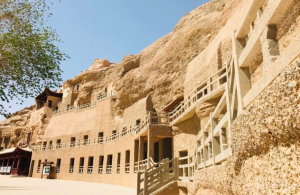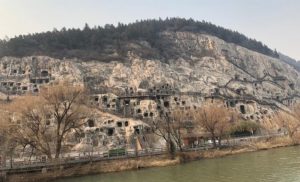 Compared with Yungang Grottoes and Mogao Grottoes, the biggest feature of Longmen Grottoes should be that it is regarded as the royal Grottoes of the Tang Dynasty. In particular, the statue of the Lushena Buddha made by Wu Zetian is full and round, with a wavy hairline on the top of the head, and double brows like a new moon, which are attached to a pair of clear eyes, and are gazing slightly below. Featuring high straight nose and small mouth, it is showing a peaceful smile. Both ears are long and slightly sag, and the lower jaw is round and slightly forward, to make it harmonious. Standing under the image of Buddha, you will feel calm and gentle.
Compared with Yungang Grottoes and Mogao Grottoes, the biggest feature of Longmen Grottoes should be that it is regarded as the royal Grottoes of the Tang Dynasty. In particular, the statue of the Lushena Buddha made by Wu Zetian is full and round, with a wavy hairline on the top of the head, and double brows like a new moon, which are attached to a pair of clear eyes, and are gazing slightly below. Featuring high straight nose and small mouth, it is showing a peaceful smile. Both ears are long and slightly sag, and the lower jaw is round and slightly forward, to make it harmonious. Standing under the image of Buddha, you will feel calm and gentle.
Compared with Yungang Grottoes, the scale of the Longmen Grottoes is obviously larger. At the same time, because of the river winds on both sides of the Yi River, the weeping willows fly gently, and the environment here is obviously better. However, the overall protection of the Longmen Grottoes is not good. Compared with the traffic limit measures of the Mogao Grottoes, there is no restriction on the traffic to the Longmen Grottoes. On the contrary, the plank road for tourists to visit is quite close to the stone sarcophagus, and some small Buddha statues are even brightly touched by the tourists, which has very great effect on the Yungang Grottoes.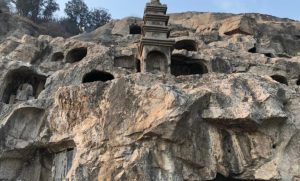
Standing in front of such a grotto, it is actually a tribute to the ancients. They may not have the modern mechanical power, but relying on their own devotion to faith, day after day, year after day, on this cliff, they open up the confession of this life and the hope of the afterlife.
If you don’t ask for explanations, it is suggested that you can listen to pocket guides, and listen to them all the way. It is still a very good way to visit, otherwise you can’t see anything, and it doesn’t mean much.

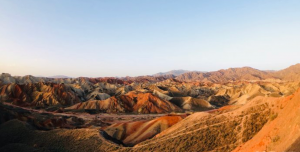 Zhangye Danxia National Geological Park is the only Danxia landform and colored hill complex in China. It is rated as one of the seven most beautiful Danxia landforms in China by China National Geographic. It mainly consists of two scenic spots, Bingou Danxia and Qicai Danxia, which are composed of red gravel, sandstone and mudstone. The unique hilly hills are colorful and magnificent. This is also the location of Zhang Yimou’s “Three Guns Surprise”, Jiang Wen’s “The Sun Also Rises” and the TV series “Detective Di Renjie”. In addition, it is also a paradise for photographers. In the scenic area, many photographers are shooting around with big cameras. If you still visit it the next day, when you buy the ticket, do remember tell the ticket seller that you should cover the seal of the next day, otherwise you will need to buy the ticket again the next day.
Zhangye Danxia National Geological Park is the only Danxia landform and colored hill complex in China. It is rated as one of the seven most beautiful Danxia landforms in China by China National Geographic. It mainly consists of two scenic spots, Bingou Danxia and Qicai Danxia, which are composed of red gravel, sandstone and mudstone. The unique hilly hills are colorful and magnificent. This is also the location of Zhang Yimou’s “Three Guns Surprise”, Jiang Wen’s “The Sun Also Rises” and the TV series “Detective Di Renjie”. In addition, it is also a paradise for photographers. In the scenic area, many photographers are shooting around with big cameras. If you still visit it the next day, when you buy the ticket, do remember tell the ticket seller that you should cover the seal of the next day, otherwise you will need to buy the ticket again the next day.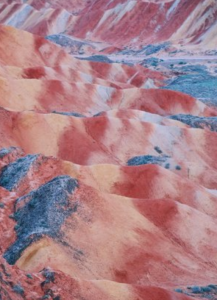 Opening hours:
Opening hours: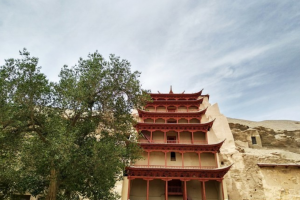 Mogao Caves is also known as the Thousand Buddha Cave, and the scenic area consists of the Mogao Grottoes Digital Exhibition Center and the Mogao Grottoes. It has a large number of murals, grottoes, cultural relics, etc. It is a world-famous Buddhist art destination.
Mogao Caves is also known as the Thousand Buddha Cave, and the scenic area consists of the Mogao Grottoes Digital Exhibition Center and the Mogao Grottoes. It has a large number of murals, grottoes, cultural relics, etc. It is a world-famous Buddhist art destination.